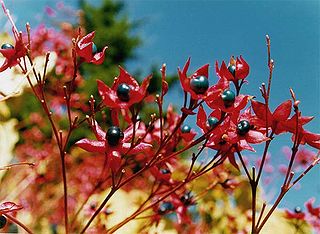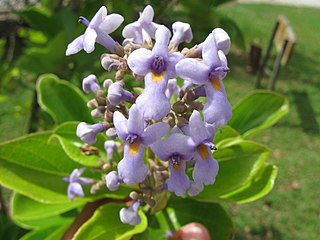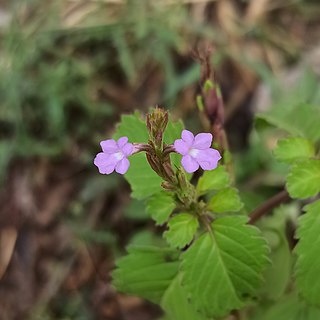
Teak is a tropical hardwood tree species in the family Lamiaceae. It is a large, deciduous tree that occurs in mixed hardwood forests. Tectona grandis has small, fragrant white flowers arranged in dense clusters (panicles) at the end of the branches. These flowers contain both types of reproductive organs. The large, papery leaves of teak trees are often hairy on the lower surface. Teak wood has a leather-like smell when it is freshly milled and is particularly valued for its durability and water resistance. The wood is used for boat building, exterior construction, veneer, furniture, carving, turnings, and various small projects.

Lantana is a genus of about 150 species of perennial flowering plants in the verbena family, Verbenaceae. They are native to tropical regions of the Americas and Africa but exist as an introduced species in numerous areas, especially in the Australian-Pacific region, South and Northeastern part of India and Bangladesh. The genus includes both herbaceous plants and shrubs growing to 0.5–2 m (1.6–6.6 ft) tall. Their common names are shrub verbenas or lantanas. The generic name originated in Late Latin, where it refers to the unrelated Viburnum lantana.

Verbena, also known as vervain or verveine, is a genus in the family Verbenaceae. It contains about 150 species of annual and perennial herbaceous or semi-woody flowering plants. The majority of the species are native to the Americas and Asia; however, Verbena officinalis, the common vervain or common verbena, is the type species and native to Europe.

Menispermaceae is a family of flowering plants. The alkaloid tubocurarine, a neuromuscular blocker and the active ingredient in the 'tube curare' form of the dart poison curare, is derived from the South American liana Chondrodendron tomentosum. Several other South American genera belonging to the family have been used to prepare the 'pot' and 'calabash' forms of curare. The family contains 78 genera with some 440 species, which are distributed throughout low-lying tropical areas with some species present in temperate and arid regions.

Ocotea bullata, is a species of flowering tree native to South Africa. It produces very fine and valuable timber which was formerly much sought after to make furniture. Due to over-exploitation it is now a protected species. Other names for it are Cape Walnut, Cape laurel, and laurel wood. The name "stinkwood" comes from a strong smell that is released when it is fresh felled.

Avicennia is a genus of flowering plants currently placed in the bear's breeches family, Acanthaceae. It contains mangrove trees, which occur in the intertidal zones of estuarine areas and are characterized by its "pencil roots", which are aerial roots. They are also commonly known as api api, which in the Malay language means "fires", a reference to the fact that fireflies often congregate on these trees. Species of Avicennia occur worldwide south of the Tropic of Cancer.

Abuta is a genus in the flowering plant family Menispermaceae, of about 32 species, native to tropical Central and South America.

Clerodendrum is a genus of flowering plants formerly placed in the family Verbenaceae, but now considered to belong to the Lamiaceae (mint) family. Its common names include glorybower, bagflower and bleeding-heart. It is currently classified in the subfamily Ajugoideae, being one of several genera transferred from Verbenaceae to Lamiaceae in the 1990s, based on phylogenetic analysis of morphological and molecular data.

Cissampelos is a genus of flowering plants in the family Menispermaceae. Various species of this genus have a history of use in various traditions of herbal medicine. Moreover, many of these plants were used as curare applied as arrow poison during hunting.

Cornutia is a genus of plants in the family Lamiaceae, first described in 1753. Species in this genus are native to tropical parts of the Western Hemisphere, including southern Mexico, Central America, the West Indies, and northern South America.

Varronia is a genus of flowering plants in the family Boraginaceae, found throughout Latin America, the Caribbean, and in the US states of Texas and Florida. They were resurrected from Cordia in 2007.
Casselia is a small genus of flowering plants in the verbena family (Verbenaceae) first named in 1823. Plants in the genus Casselia are native to South America.
Telitoxicum is a genus of flowering plants belonging to the family Menispermaceae.

Bouchea is a genus of flowering plant belonging to the family Verbenaceae.
Rehdera is a genus of flowering plants belonging to the family Verbenaceae.
Lampayo is a genus of flowering plants belonging to the family Verbenaceae.

Carex bullata is a tussock-forming species of perennial sedge in the family Cyperaceae. It is native to south eastern parts of Canada and eastern parts of the United States. It has the common name of the button sedge.
Abuta pahnii is a species of the Abuta genus, which is part of the flowering plant family Menispermaceae. This genus consists of about 32 species, native to tropical Central and South America.
Abuta fluminum is a species of flowering plant in the family Menispermaceae.
Abuta chocoensis is a species of flowering plant in the family Menispermaceae found near Chocó in Colombia between Rio San Pablo and Las Animas. It is part of the Abuta genus, which consists of about 32 species native to tropical Central and South America.











